
In 2020 Friends of Kaw Point Park was awarded a grant by the Lewis and Clark Heritage Trail Foundation to fund the Historic Native Plants project. We have identified 20 native plant species in Kaw Point Park with signage. These plant species were identified by Lewis and Clark in the Kansas and Missouri geographic area in the early 1800s. Each sign has a QR code that is linked to one of the sections below and gives the participant more information about the specific plant. Please enjoy this “on the trail” educational experience at the park to learn more about the Lewis and Clark Expedition.
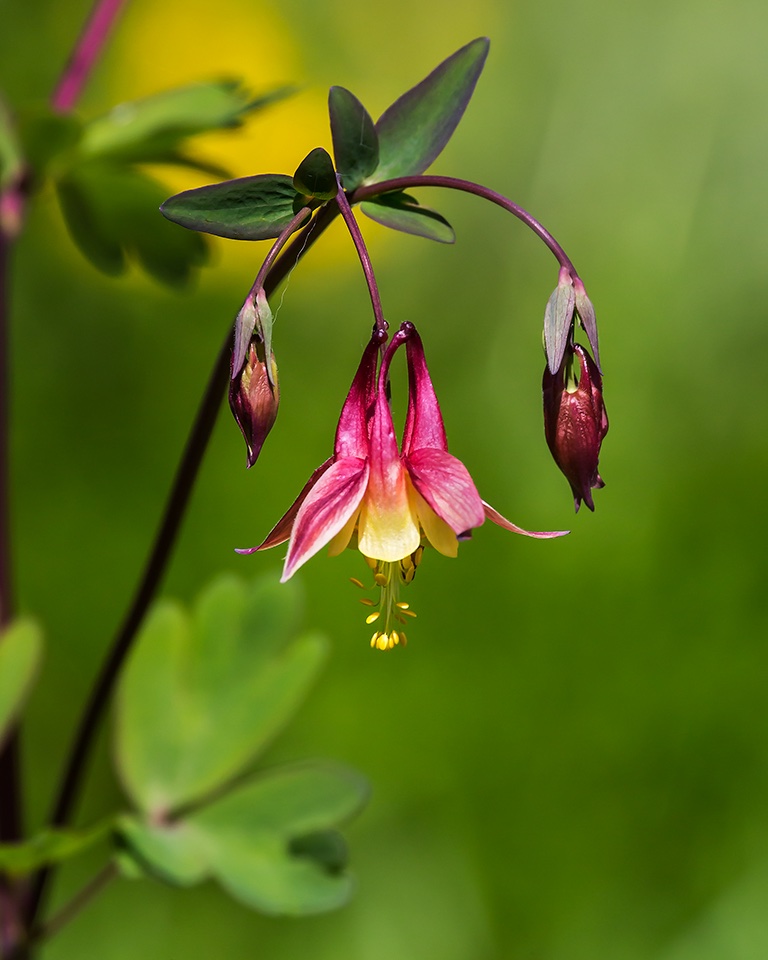
Columbine (Aquilegia canadensis)
When the expedition arrived at Fort Mandan (present day North Dakota), Lewis had collected approximately 100 plants. Specimen 100 was Columbine which was collected near the Fort. Lewis packed all the plants and other articles (skins of mammals, live animals in gages, etc.) in a keel boat and sent it down river to President Jefferson. There were several plant specimens that were lost and one of them was the Columbine. Lewis wrote about the Columbine saying: “Novr. 17th [1804] the seed of a plant given me by the recaray [Arikara] chief [Piaheto] who accompanied us to the mandanes[.] he informed me that a tea of the seed was a strong diaerettic – and that the squaws chewed them and rubed their hair with them as perfume.” Columbine is a plant that grows to 2 feet tall. Often you will see them growing off of cliff faces or rock outcrops in the shade. Flowers are on a single stem and the outer parts are red while the inner parts are a light yellow. The flower blooms from April-July.
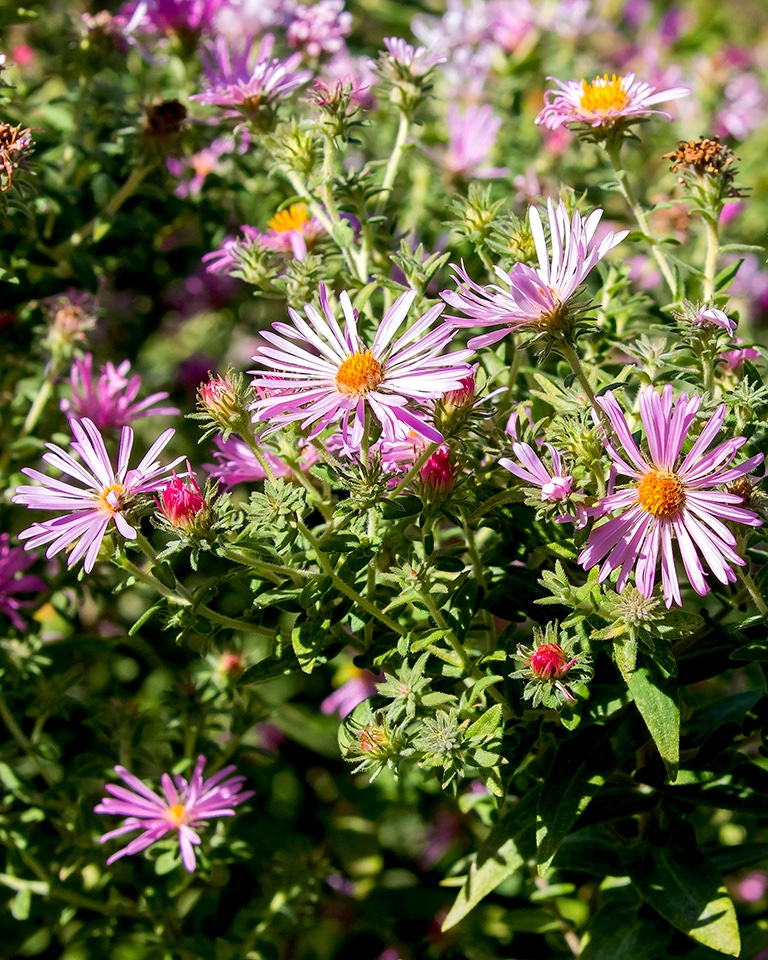
Aromatic aster (Aster oblongifolius)
This specimen was collected on September 21, 1804 at the Big Bend of the Missouri near present day Lower Brule, South Dakota. Around September is when small bluish purple flowers appear on this plant. Lewis and Clark experienced this colorful plant when they were exploring the area around Big Bend. Aromatic aster is a perennial plant reaching a height of 3 feet. It has an aromatic smell when the leaves are rubbed between the fingers. Many beautiful bluish purple flowers arrive in the fall and some may stay on the plant until November.
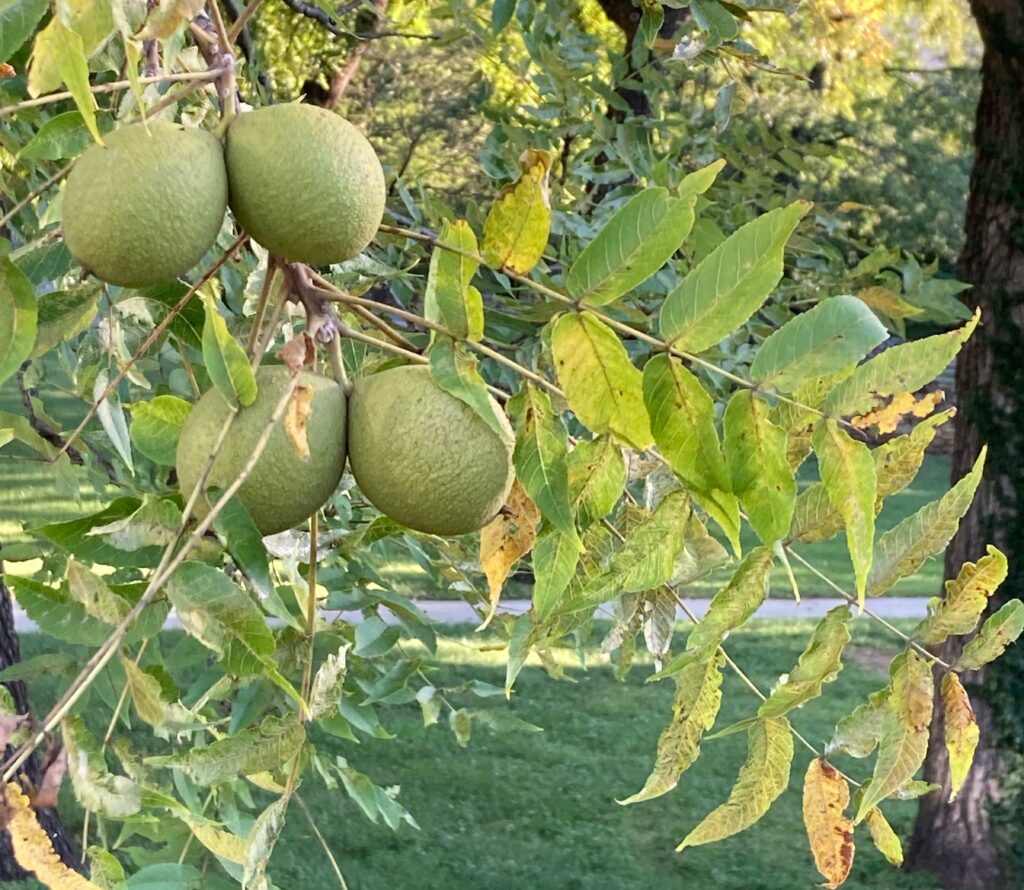
Black walnut (Juglans nigra)
On July 3, 1804, near present day Fort Leavenworth, Captain Ordway of the expedition describes the scene: “The land is Good high bottom pine Timber & black walnut honey locas…. I Saw waat they call bucks Eye with the nuts on them…” The Black walnut is a tree reaching a height of 90 feet. It has large compound leaves with 13-23 leaflets. Around September, a green, globular shaped fruit (walnut) appears amongst the leaves. Black walnut grows in woods at the base of slopes and along bottomland forests and near streams. The brown to black nuts are eaten by mice and squirrels. The wood is used to make furniture, cabinets, veneers, musical instruments, and gunstocks.
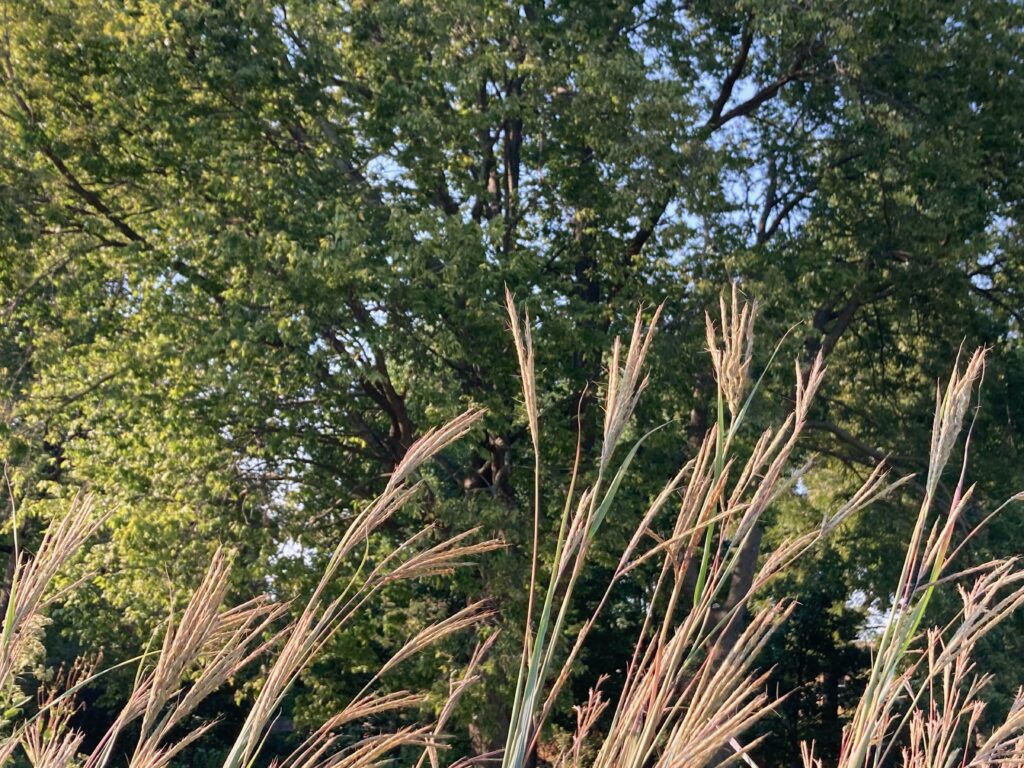
Big bluestem (Andropogon gerardii)
Lewis collected various grass species but Big Bluestem was the most abundant grass he observed on the Tallgrass prairie. On July 27, 1804 (near present day Bellevue, Nebraska), Lewis collected 6 grass species. He mentions on his list the following: “No 22. 23. 24 & 25. Are various species of grasses which appear in the praries, No. 23 [Big bluestem] is the most common of any other grass, it rises to the hight of 4 to 8 feet & never bears any flower or seed that I ever observed and suppose therefore that it must propegate by means of the root: common to all praries in this country.” Big Bluestem is a perennial grass that has flowering stalks averaging 3-6 feet tall and occassionally to 9 feet. This tall grass is also called “turkey foot” due to the arrangement of the flower heads. During the fall the leaves turn a purplish-red. This plant was used by Native Americans to treat digestive problems. In Kansas, the Flint Hills were once called the “bluestem pastures.”
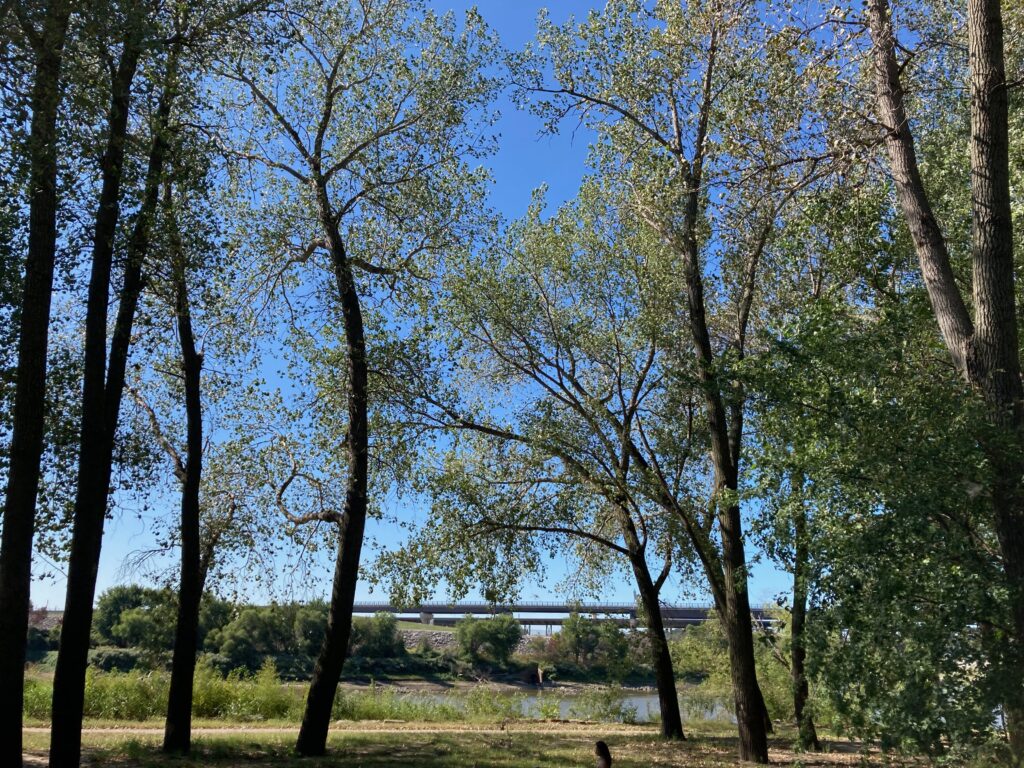
Cottonwood (Populus deltoides)
Lewis collected plains cottonwood on May 25, 1804, at La Charette, Missouri. On a list, he describes the tree: “No. 4 … this specimine is the seed of the Cottonwood which is so abundant in this country, it has now arrived at maturity and the wind when blowing strong drives it through the air to a great distance being supported by a parrishoot of this cottonlike substance which give the name to the tree …” The expedition made great use of the wood from this tree. They used it for shelter, for canoes (pirogues), for wheels and axles for hauling cargo around long portages, and for building Fort Mandan. Cottonwood is the state tree of Kansas. Cottonwood trees that grow along river banks may reach a height of 30 meters. The leaves are triangular with a pointed tip. The stalk of the leaf (called a petiole) is flattened which causes the leaf to flutter in the breeze. In the fall, the tree’s leaves turn a bright yellow. Native Americans considered cottonwoods a “sacred tree of life.”

Elderberry (Sambucus canadensis)
Lewis and Clark mentioned Elderberry several times in their journals. The species they described was the Blue Elderberry, a relative of the Elderberry we have here at the park. On December 1, 1805, Lewis saw near the mouth of the Columbia River, “the large elder with skey blue buries.” The color of the fruit of the Elderberry in this area is deep purple. The fruit is small and hangs in clusters from the top of the plant. Elderberry is a thicket-forming shrub reaching a height of 6-10 feet. The berries are eaten by about 45 bird species and are used to make pies, wines, and jellies.
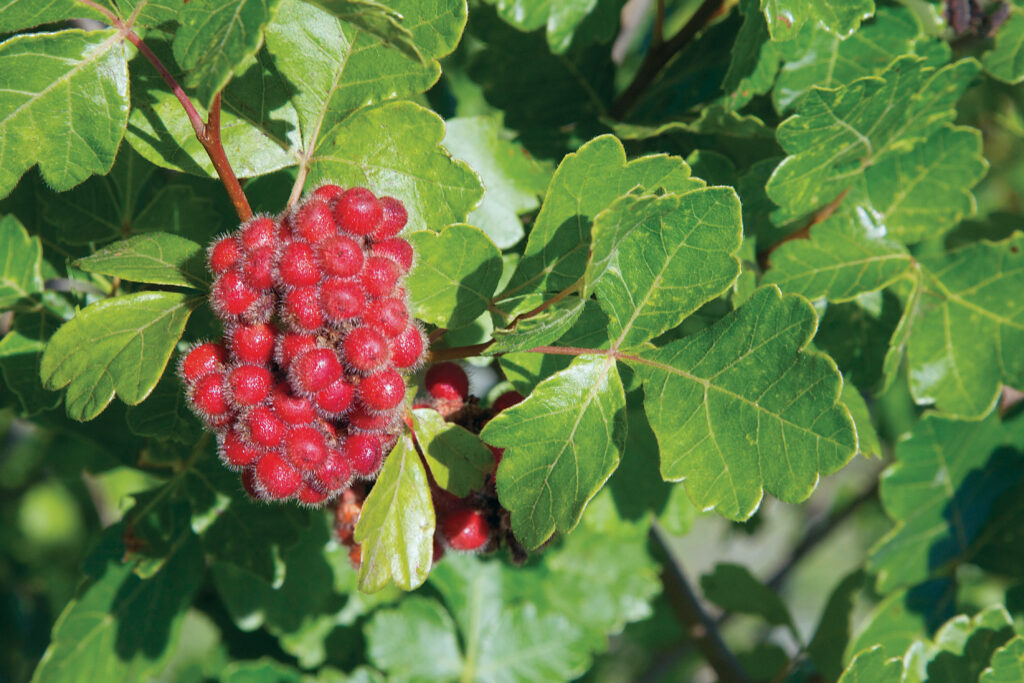
Fragrant sumac (Rhus aromatica)
Lewis wrote in his journal: “No. 57. October 1st 1804 first discovered in the neighborhood of the Kancez River [the expedition camped at Kaw Point on June 26, 1804] – now very common, the growth of the little cops which appear on the steep declivities of the hills where they are sheltered from the ravages of the fire.” Fragrant sumac is a small deciduous shrub that grows to a height of 3-6 feet. In the spring the yellow flowers will appear before or after the leaves. Also, this woody shrub is called Aromatic sumac because when the leaves are crushed between the fingers it gives off a skunky odor. In late July, red, round fruits appear and in the fall the leaves will turn a color of yellow, purple, and red. Wood rats, mice, and rabbits eat the bark during the winter.
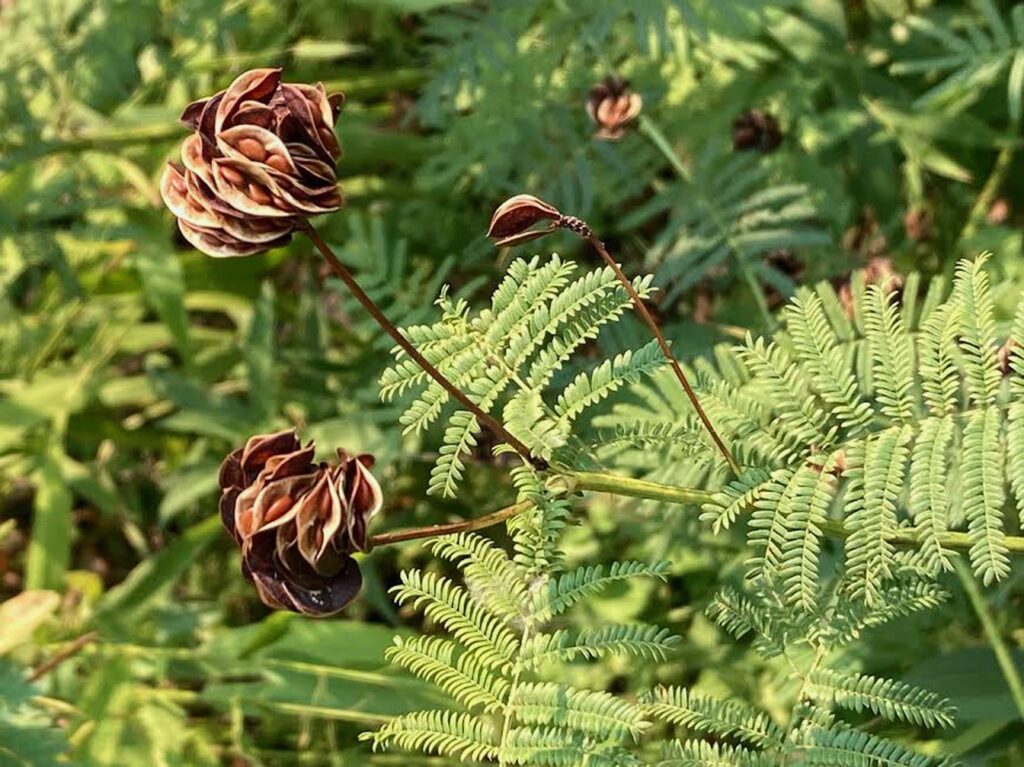
Illinois bundleflower (Desmanthus illinoensis)
Lewis describes this plant in his journal: …”its flower is of a gloubelar form composed of a number of fibers of a yellowish white, and produces as a fruit a bunch of little pees which are all bent edgeways into the form of a semicircle and so closely connected and compressed as to form a globular figure of a curious appearance.” Illinois bundleflower is a perennial plant with compound leaves. It can grow to a height of 2-6 feet and the tiny, white flowers bloom June – August. It is a relative of the mimosa plant. This is a legume that is consumed readily by livestock. Bundleflower seeds provide high quality food for wildlife. In the winter, the curved seed pods stay on the plant.

Pawpaw (Asimina triloba)
Merriwether Lewis and William Clark and the men called it the custard apple. There were no known plant specimens collected, but from Clark’s journals he mentions several times that Pawpaws were eaten by the men. In fact, on the final leg of the expedition (September 11, 1806), the men were running out of provisions. Down stream from the Kansas River Clark said, “we landed one time only to let the men geather Pappaws or the Custard apple of which this Country abounds, and the men are very fond of.” Pawpaw is a small understory tree reaching a height of 5 meters. In April, look for flowers of a dark purple color. And, in the summer months, it has large green leaves that stand out among the other species of trees. The fruit is greenish-yellow with blotches of dark brown. The fruit is edible as soon as it becomes soft, usually around late September or early October. The fruit is eaten by various bird species and by squirrels.
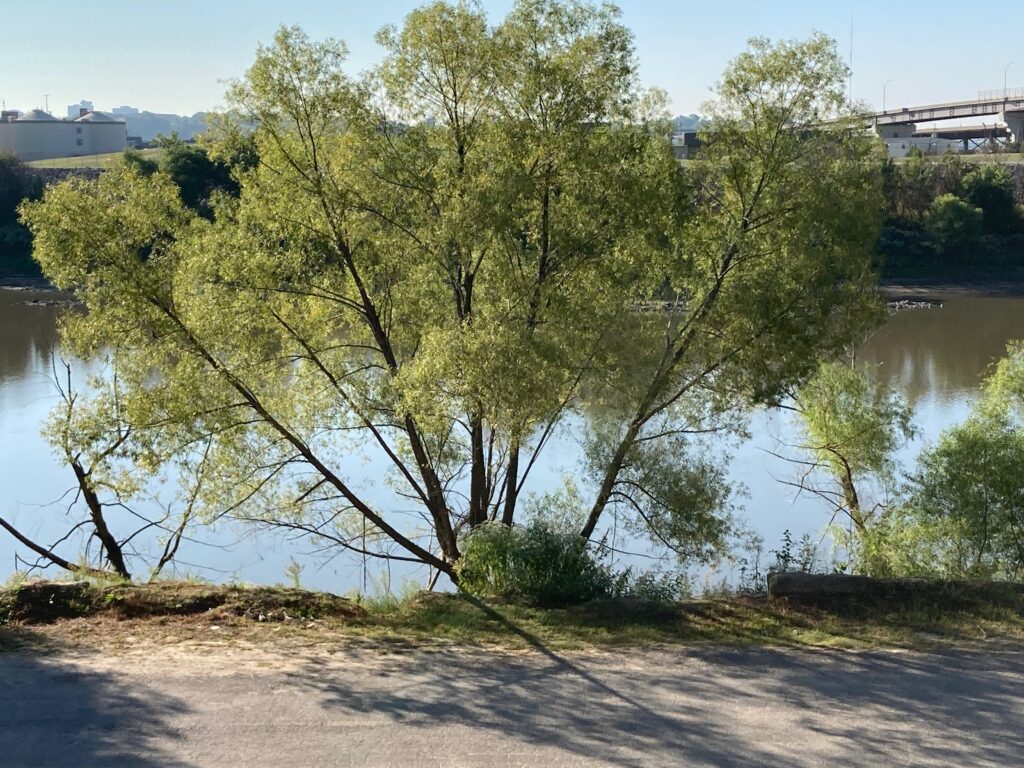
Peach-leaved willow (Wide leaf) (Salix amygdaloides) and/or Black willow (Narrow leaf) (Salix nigra)
From the journals, Lewis described the leaf of this tree collected June 14, 1804: “No. 14 The wide leaf willow or that species which I believe to be common to most parts of the Atlantic States. it grows in similar situations to that described with rispect to the narrow leaf williow, but is never found in such abundance, it arrives to a greater size sometimes to forty feet in hight and eighteen inches in diameter, the leave is smoth ovate, pointed, finely indented, a pale green on the upper side and of a whiteis green or silver coulour underneath – like the narrow leaf willow the leaf is widest in the middle where it is from one inch to 3/4 wide. – it bears its seed in the manner described of the other and the plants ar likewise male and female.” There are two large willows in Kansas – Peach-leaved willow and Black willow. Black willow is common at the park existing along the banks of the Kansas and Missouri Rivers. The leaves of the Black willow are more narrow than Peach-leaved willow. Peach-leaved has a whitened underside of the leaves. At maturity, willows can reach a height of approximately 40 feet. The trunk of the tree leans and often will extend out over a stream or river bank. The root system is extensive and will keep a stream bank from eroding away.
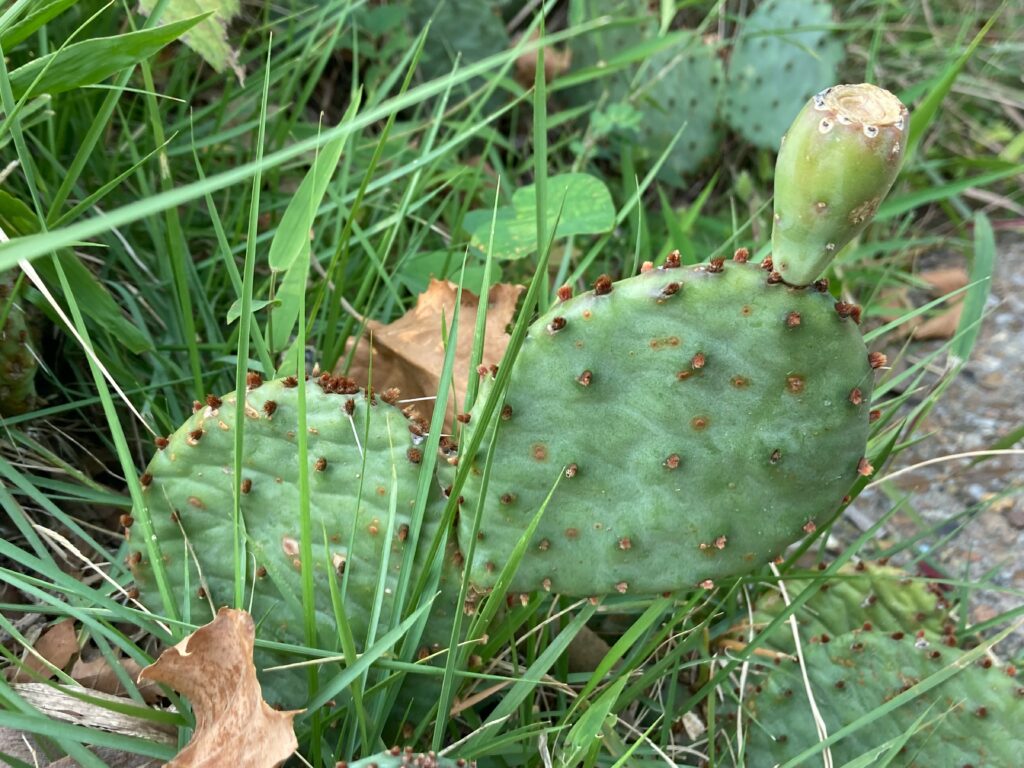
Plains prickly pear (Opuntia macrorhiza)
Lewis and Clark mentioned Prickly pear often in their journals. Lewis wrote about the Plains prickly pear above Great Falls [Montana] and said, “the prickly pear is now in full blume and forms one of the beauties as well as the greatest pests of the plains.” Lewis went on and said, “did not think it prudent to remain all night at this place which really from the succession of curious adventures wore the impression on my mind of inchantment; at sometimes for a moment I thought it might be a dream, but the prickley pears which pierced my feet very severely once in a while, particularly after it grew dark, convinced me that I was really awake.” This low spreading, spiny plant is usually less than 1/2 foot tall. The large, flattened blue-green stem segments, called pads, are 3-5 inches long and 2-3 inches wide. These pads bear a cluster of a few to many stout spines and hairlike bristles that are very difficult to remove from the skin once they are embedded. The flowers are yellow and bloom between May to July. The fruit is purplish red and edible.
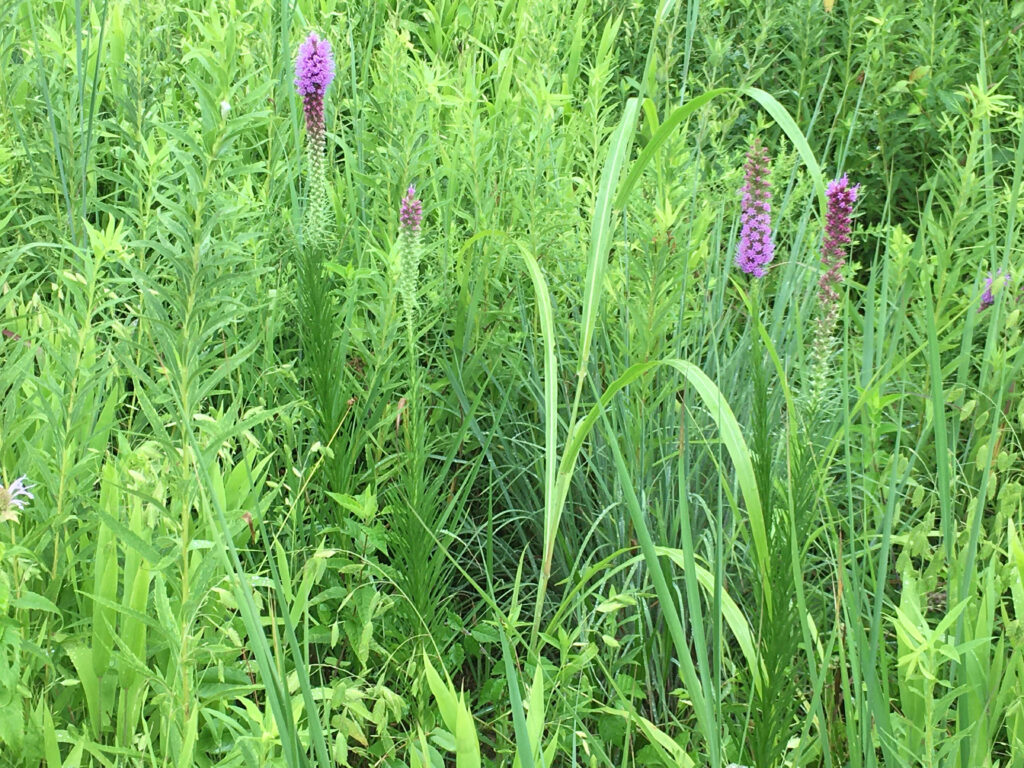
Prairie blazingstar (Liatris pycnostachya)
This was one of the 100 plant specimens sent down the Missouri from Fort Mandan. Lewis collected this plant on September 18, 1804. The explorers were traveling near present day Oacoma, South Dakota. A specimen of this plant still exists today with an original marked label [No. 35]. Around July to August, several tall, wand-like spikes of rose-purple flowers appear. Prairie blazingstar is a perennial plant common throughout the Tallgrass region reaching a height of 2-5 feet. It is another popular flowering plant for pollinators.

Plains coreopis (Coreopsis tinctoria)
A label exists for this plant, however, a botanists by the name of Frederick Pursh wrote on the label, “On Lewis’s R. [Snake River] Octbr: 1805.” The expedition was near present day Riparia, Washington. They were paddling canoes on the Snake river and were experiencing several bad rapids. One of the rapids was very long, approximately 2 miles in length. Plains coreopsis and Columbia tickseed (what was on the label) are the same species. Plains coreopsis is an annual plant reaching a height of 2-4 feet. The flowerheads have 7-9 yellow ray florets with a prominent reddish center. This plant blooms in June-August and often forms dense yellow stands. Another relative of this plant and thriving at the park is Lanceleaf coreopsis (Coreopsis lanceolata). It is a perennial that likes growing amongst the rocky areas in the gardens. This plant produces many yellow flowers in early to mid-spring.
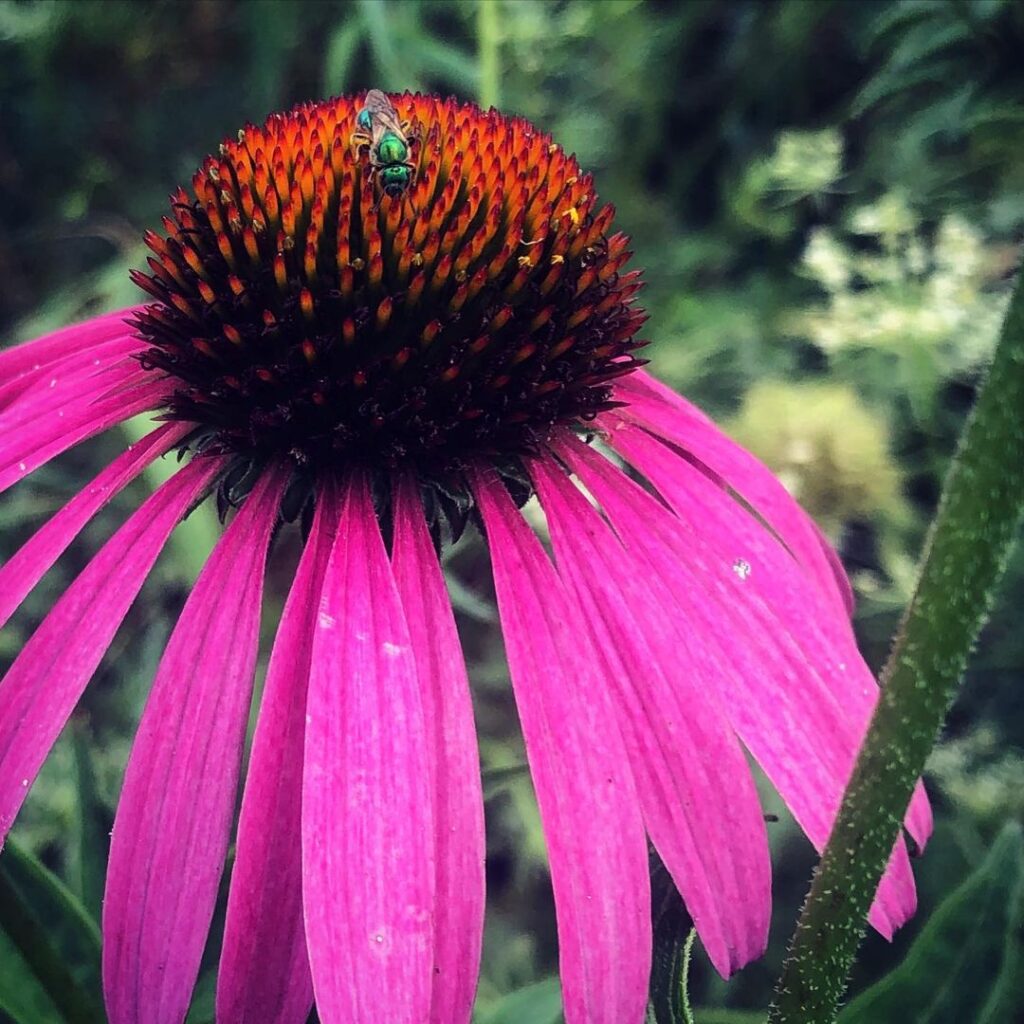
Purple coneflower (Echinacea angustifolia)
Merriweather Lewis’s mother was good with the medicinal properties of plants and taught young Merriweather and others how to use herbs to heal. In the journals, Clark mentions the importance of this medicinal plant. According to a list that was sent down the river to President Jefferson, Clark wrote: “…some Ricaras [Arikara] tobacco seed …a ear of Mandan Corn …a Carrote of Ricaras Tobacco …Specimens of Plants frome 1 to 60…a Specimon of a plant, and a parcel of its roots higly prized by the natives as an efficatious remidy in cases of the bite of the rattle Snake or Mad Dog.” He went on to say, “the root wen pounded in either green or dryed state makes an excellent poltice for swellings or sour throat…” Purple coneflower is a perennial plant reaching a height of 1-3 feet. Flowers have ray petals that are purplish-pink and spread from a dark, spiny cone in the center. Purple coneflowers are favored by many butterflies and bird species such as the Monarch and American Goldfinch.
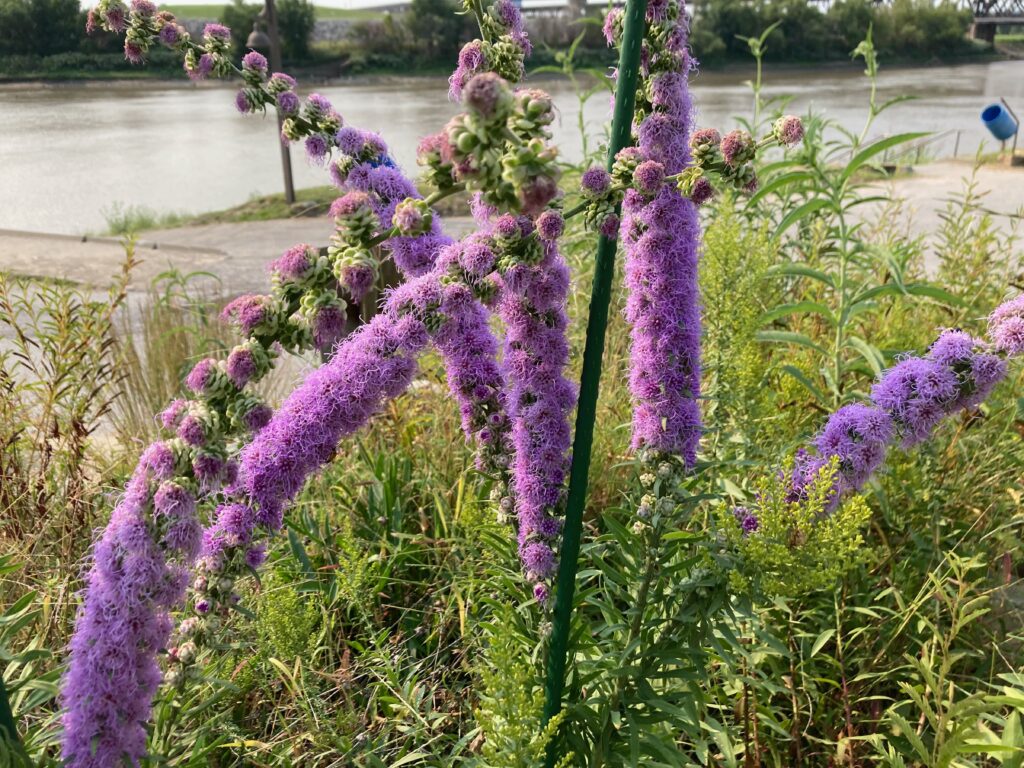
Rough blazingstar (Liatris aspera)
Rough blazingstar was one of approximately 100 plants sent back to President Jefferson from Fort Mandan. This plant (No.58) was collected on September 12, 1804 in present day Brule County, South Dakota, near the mouth of the White River. Around late August and early September is when this tall, stalked plant produces many pinkish purple flowers. It is a perennial plant reaching a height of 4-5 feet. This beautiful plant flowers when the Monarch’s migrate.
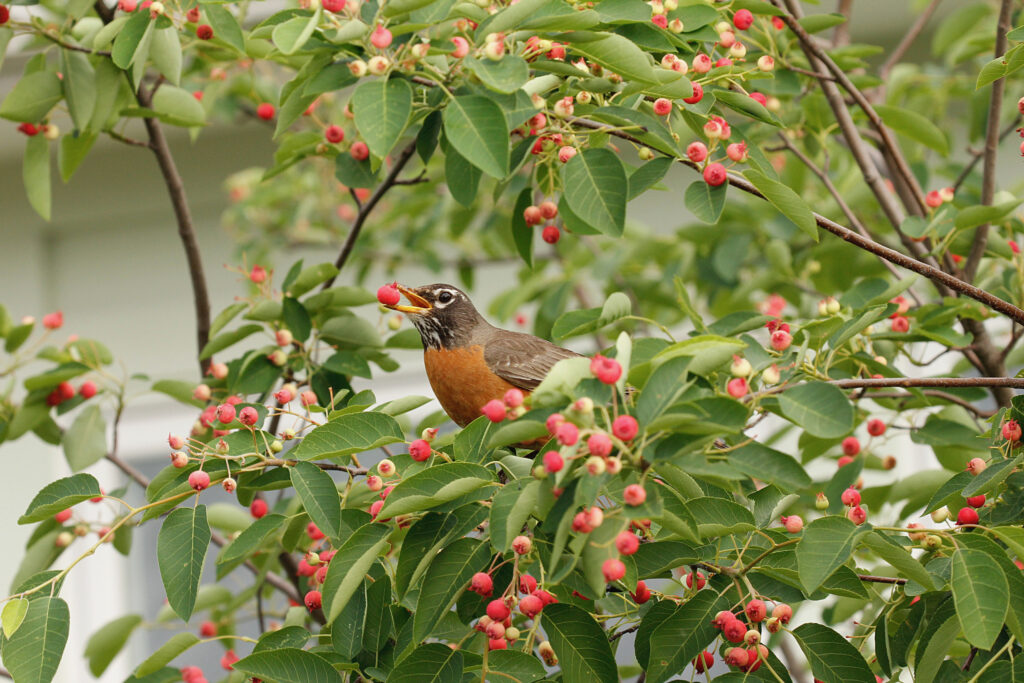
Serviceberry (Amelanchier arborea)
Near the Columbia River (present day Washington State), Lewis wrote in his journal on Tuesday, August 13,1805 that they met a party of about 60 warriors mounted on horses. Lewis confronted a chief of the party who immediately embraced him affectionately. Later, they all sat down in a circle and smoked a peace pipe. Lewis informed the chief that they had nothing to eat since the day before. The chief said he had nothing but berries to eat and so gave Lewis and Clark’s party some cakes of serviceberries and choke cherrys. Afterwards, Lewis wrote in his journal that he made a hearty meal of those berries. The Western Serviceberry that Lewis describes is similar to the species in Kansas and Missouri. Serviceberry is a small tree or shrub that grows on hillsides among other species of trees. It can grow up to 8 meters in height. White flowers appear before the leaves in early April. Purple fruits will ripen in June. Birds, such as Robins, are fond of the fruits and will pluck them off as soon as they turn purple. Serviceberries are edible and have a taste similar to that of the blueberry.
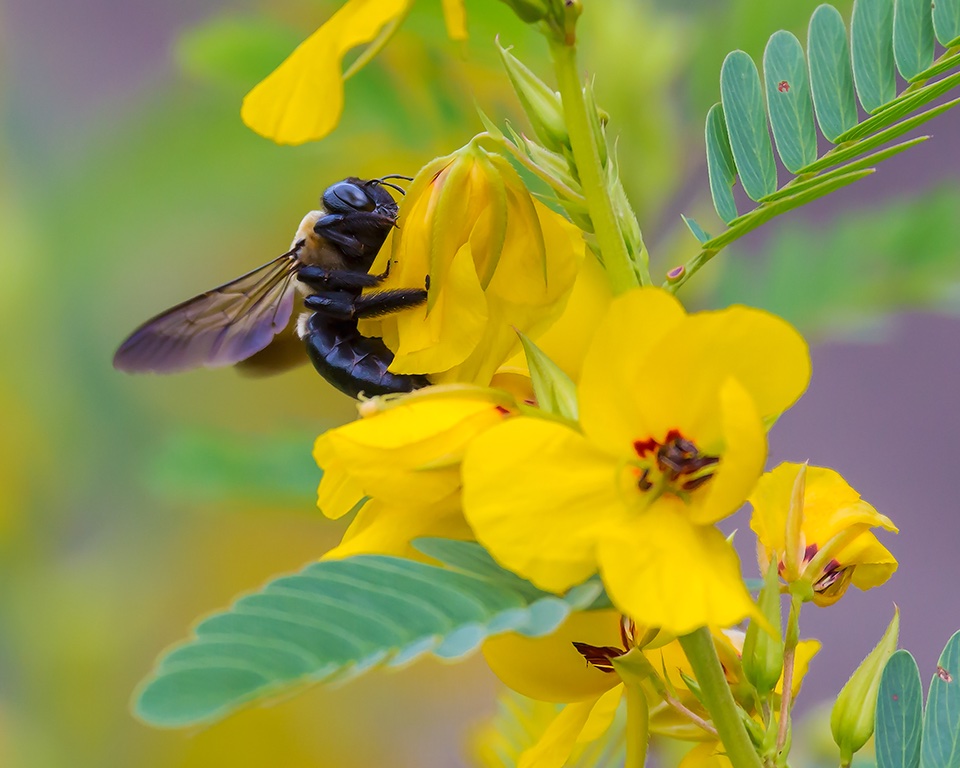
Showy partridge pea (Chamaecrista fasciculata)
Lewis’s list this particular plant in his journal: “Taken on the 18th of July. [1804] – an annuel plant putting up many branches from the root has a leaf like the pateridge bea [partridge bean], is jointed bears a number of yllow pea-like flowers which grow on the seed stems which project from the main branches and which are unattended with leaves; these flowers grow all around this stem and give it the appearance of a tausell. The {l} eaf stems ar long and have 24 par of leaves.” This annual flowering plant grows to a height of 1/2 – 4 feet. It has compound leaves that fold at night. Yellow flowers appear in the summer. Several bee and wasp species love the flowers and the pod-like seeds of the plant are eaten by a variety of birds.
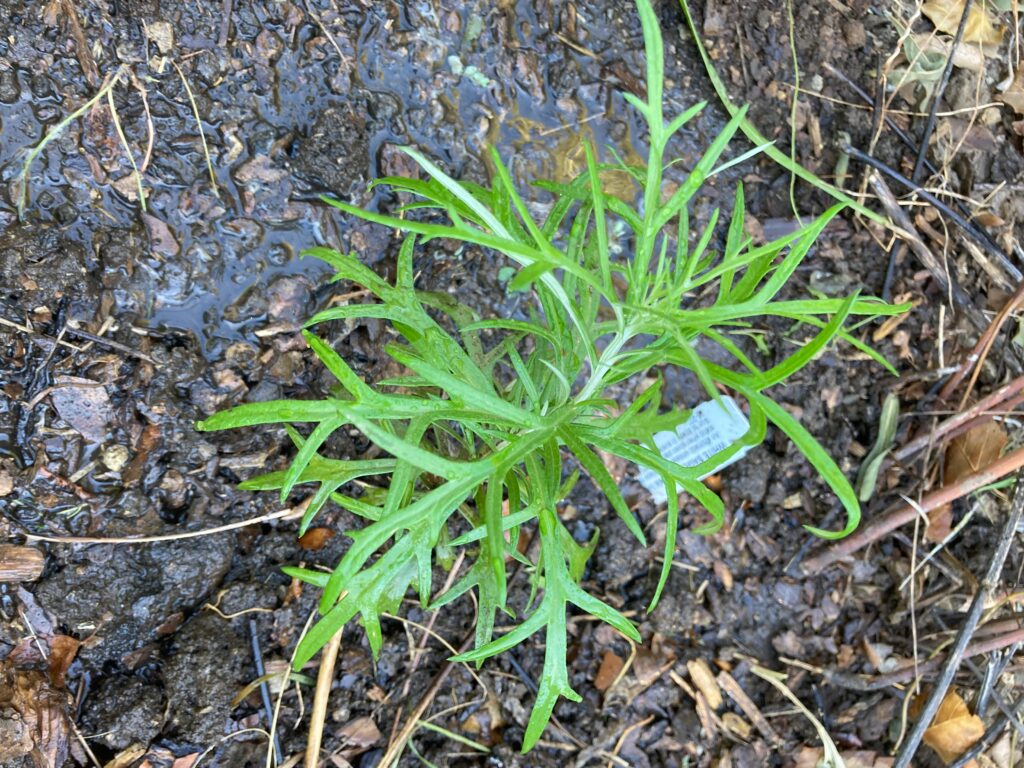
White sage (Artemisia ludoviciana)
Lewis wrote in his journal on July 13, 1804: “No 30. was taken at the bald praries and is common to both low and high praries it usually grows in a single stem and appears to be an annual groath the leaves are white and like the stem appear to be covered with a white down – this is common to all the praries above the Kancez [Kansas] river; from it’s resemblence in taste smell &c [etc.] to the common Sage I have called it the wild Sage.” White sage is an aromatic, white hairy plant reaching a height of 3 feet. There are many small brownish flower heads that occur in the summer to early fall. The leaves produce a sage-like aroma when it is rubbed between the fingers. The Native Americans would use this plant for medicinal and ceremonial purposes. The branches can be dried and used in wreaths and bouquets.
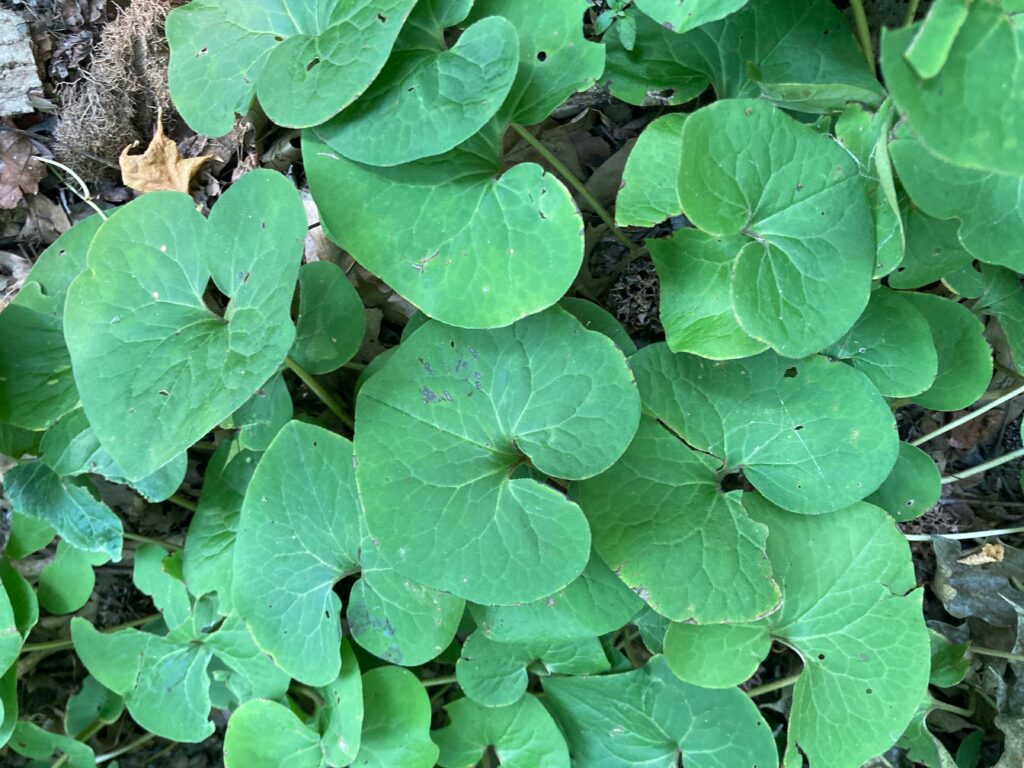
Wild ginger (Asarum canadense)
Lewis wrote about this perennial herb and said, “was taken the 1st of June [1804] at the mouth of the Osage river; it is known in this country by the name of the wild ginger, it resembles that plant somewhat in both taste and effect; it is a strong stomatic stimelent, and frequently used in sperits with bitter herbs – it is common throughout the rich lands in the Western country.” Wild ginger is a low growing plant that has large heart-shaped leaves. Flowers are usually hidden by the leaves and come out in April-May. The roots are fleshy and have a distinct aroma of ginger. Deciduous forests is where this plant is commonly found. It grows on wooded slopes and likes rich soils.
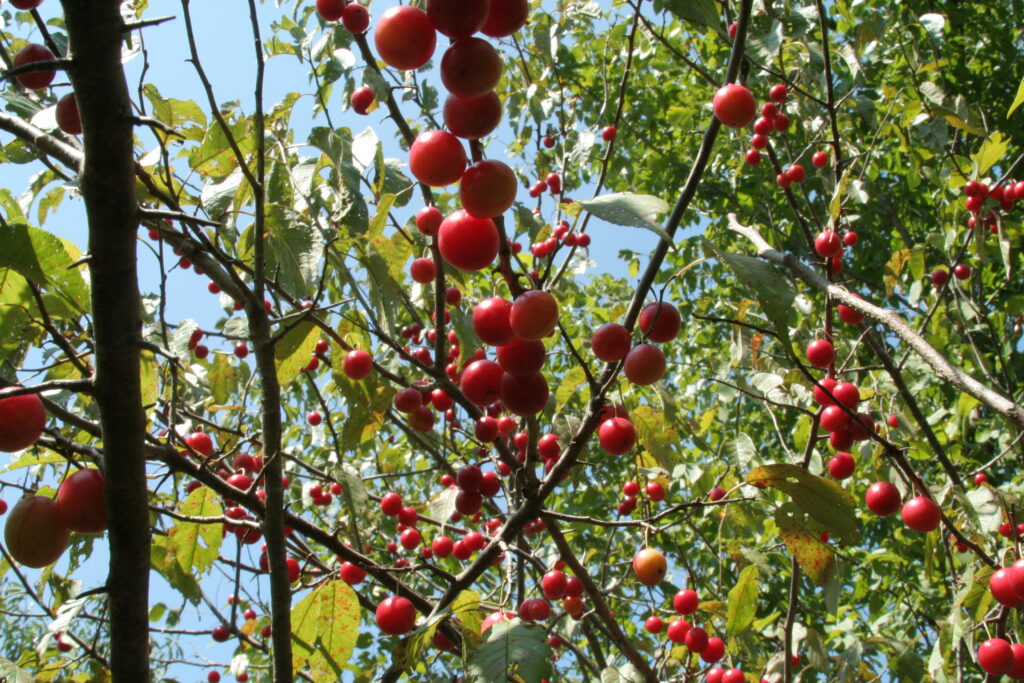
Wild plum (Prunus americana)
Near the mouth of Chariton river on June 10, 1804, Clark wrote in his journal “… Those Praries are not [open] like those, or a number of those E. of the Mississippi Void of every thing except grass, they abound with Hasel Grapes & a wild plumb of a Superior quallity, Called the Osages Plumb Grows on a bush the hight of a Hasel (and is three times the sise of other Plumbs,) and hang in great quantities on the bushes I saw great numbers of Deer in the Praries, the evening is Cloudy, our party in high Spirits.” Wild plum is a shrub or small tree. Its white flowers bloom early April and usually with or before the leaves. The fruit is red and ball-shaped and about 1 inch wide. Wild plums are sweet and edible when ripe. They make great jellies and preserves, but are also a favorite of birds and other animals.
